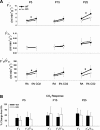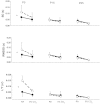Subtle alterations in breathing and heart rate control in the 5-HT1A receptor knockout mouse in early postnatal development
- PMID: 22936722
- PMCID: PMC3524655
- DOI: 10.1152/japplphysiol.00939.2012
Subtle alterations in breathing and heart rate control in the 5-HT1A receptor knockout mouse in early postnatal development
Abstract
We hypothesized that absence of the 5-HT(1A) receptor would negatively affect the development of cardiorespiratory control. In conscious wild type (WT) and 5-HT(1A) receptor knockout (KO) mice, we measured resting ventilation (Ve), oxygen consumption (Vo(2)), heart rate (HR), breathing and HR variability, and the hypercapnic ventilatory response (HCVR) at postnatal day 5 (P5), day 15 (P15), and day 25 (P25). In KO mice compared with WT, we found a 17% decrease in body weight at only P5 (P < 0.01) and no effect on Vo(2). Ve was significantly (P < 0.001) lower at P5 and P25, but there was no effect on the HCVR. Breathing variability (interbreath interval), measured by standard deviation, the root mean square of the standard deviation (RMSSD), and the product of the major (L) and minor axes (T) of the Poincaré first return plot, was 57% to 187% higher only at P5 (P < 0.001). HR was 6-10% slower at P5 (P < 0.001) but 7-9% faster at P25 (P < 0.001). This correlated with changes in the spectral analysis of HR variability; the low frequency to high frequency ratio was 47% lower at P5 but 68% greater at P25. The RMSSD and (L × T) of HR variability were ~2-fold greater at P5 only (P < 0.001; P < 0.05). We conclude that 5-HT(1A) KO mice have a critical period of potential vulnerability at P5 when pups hypoventilate and have a slower respiratory frequency and HR with enhanced variability of both, suggesting abnormal maturation of cardiorespiratory control.
Figures






Similar articles
-
Severe spontaneous bradycardia associated with respiratory disruptions in rat pups with fewer brain stem 5-HT neurons.Am J Physiol Regul Integr Comp Physiol. 2009 Jun;296(6):R1783-96. doi: 10.1152/ajpregu.00122.2009. Epub 2009 Apr 15. Am J Physiol Regul Integr Comp Physiol. 2009. PMID: 19369586 Free PMC article.
-
Brainstem serotonin deficiency in the neonatal period: autonomic dysregulation during mild cold stress.J Physiol. 2011 Apr 15;589(Pt 8):2055-64. doi: 10.1113/jphysiol.2010.203679. Epub 2011 Feb 28. J Physiol. 2011. PMID: 21486799 Free PMC article.
-
Failed heart rate recovery at a critical age in 5-HT-deficient mice exposed to episodic anoxia: implications for SIDS.J Appl Physiol (1985). 2011 Sep;111(3):825-33. doi: 10.1152/japplphysiol.00336.2011. Epub 2011 Jun 16. J Appl Physiol (1985). 2011. PMID: 21680874 Free PMC article.
-
[Autonomic regulation and bradycardia during the neonatal period].Arch Pediatr. 2014 Feb;21(2):226-30. doi: 10.1016/j.arcped.2013.10.001. Epub 2013 Nov 26. Arch Pediatr. 2014. PMID: 24290181 Review. French.
-
Assessing aversive emotional states through the heart in mice: implications for cardiovascular dysregulation in affective disorders.Neurosci Biobehav Rev. 2009 Feb;33(2):181-90. doi: 10.1016/j.neubiorev.2008.08.015. Epub 2008 Sep 7. Neurosci Biobehav Rev. 2009. PMID: 18824021 Review.
Cited by
-
Cannabidiol reduces lung injury induced by hypoxic-ischemic brain damage in newborn piglets.Pediatr Res. 2017 Jul;82(1):79-86. doi: 10.1038/pr.2017.104. Epub 2017 May 3. Pediatr Res. 2017. PMID: 28388598
-
Medullary serotonin neurons are CO2 sensitive in situ.J Neurophysiol. 2013 Dec;110(11):2536-44. doi: 10.1152/jn.00288.2013. Epub 2013 Sep 18. J Neurophysiol. 2013. PMID: 24047906 Free PMC article.
-
Serotonin 1A Receptor Pharmacotherapy and Neuroplasticity in Spinal Cord Injury.Pharmaceuticals (Basel). 2022 Apr 11;15(4):460. doi: 10.3390/ph15040460. Pharmaceuticals (Basel). 2022. PMID: 35455457 Free PMC article. Review.
-
Persistent Expression of Serotonin Receptor 5b Alters Breathing Behavior in Male MeCP2 Knockout Mice.Front Mol Neurosci. 2018 Feb 20;11:28. doi: 10.3389/fnmol.2018.00028. eCollection 2018. Front Mol Neurosci. 2018. PMID: 29515365 Free PMC article.
-
Point process modeling of interbreath interval: a new approach for the assessment of instability of breathing in neonates.IEEE Trans Biomed Eng. 2013 Oct;60(10):2858-66. doi: 10.1109/TBME.2013.2264162. Epub 2013 May 31. IEEE Trans Biomed Eng. 2013. PMID: 23739777 Free PMC article.
References
-
- Akselrod S, Gordon D, Madwed JB, Snidman NC, Shannon DC, Cohen RJ. Hemodynamic regulation: investigated by spectral analysis. Am J Physiol Heart Circ Physiol 249: H867–H875, 1985 - PubMed
-
- Ase AR, Reader TA, Hen R, Riad M, Descarries L. Altered serotonin and dopamine metabolism in the CNS of serotonin 5-HT(1A) or 5-HT(1B) receptor knockout mice. J Neurochem 75: 2415–2426, 2000 - PubMed
-
- Audero E, Coppi E, Mlinar B, Rossetti T, Caprioli A, Banchaabouchi MA, Corradetti R, Gross C. Sporadic autonomic dysregulation and death associated with excessive serotonin autoinhibition. Science 321: 130–133, 2008 - PubMed
-
- Azmitia EC. Serotonin neurons, neuroplasticity, and homeostasis of neural tissue. Neuropsychopharmacology 21: 33S–45S, 1999 - PubMed
Publication types
MeSH terms
Substances
Grants and funding
LinkOut - more resources
Full Text Sources
Research Materials
Miscellaneous

